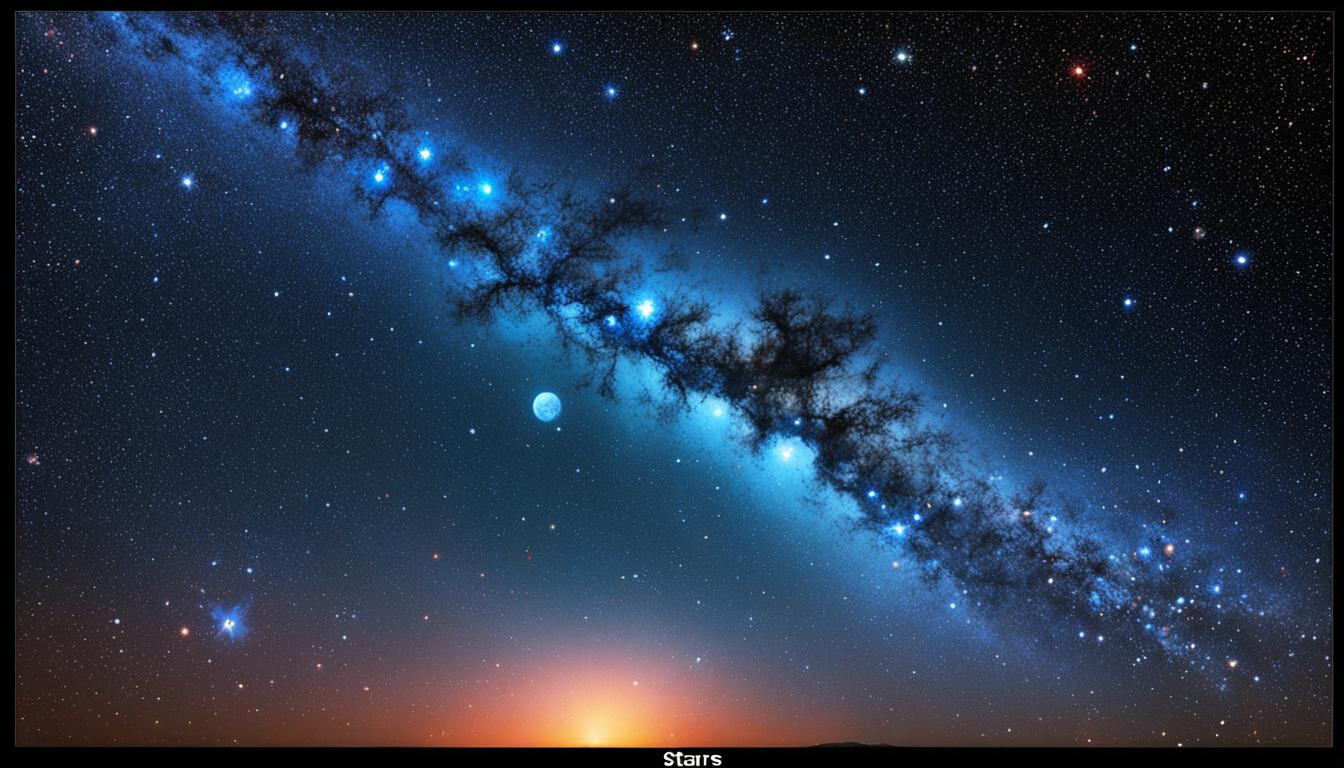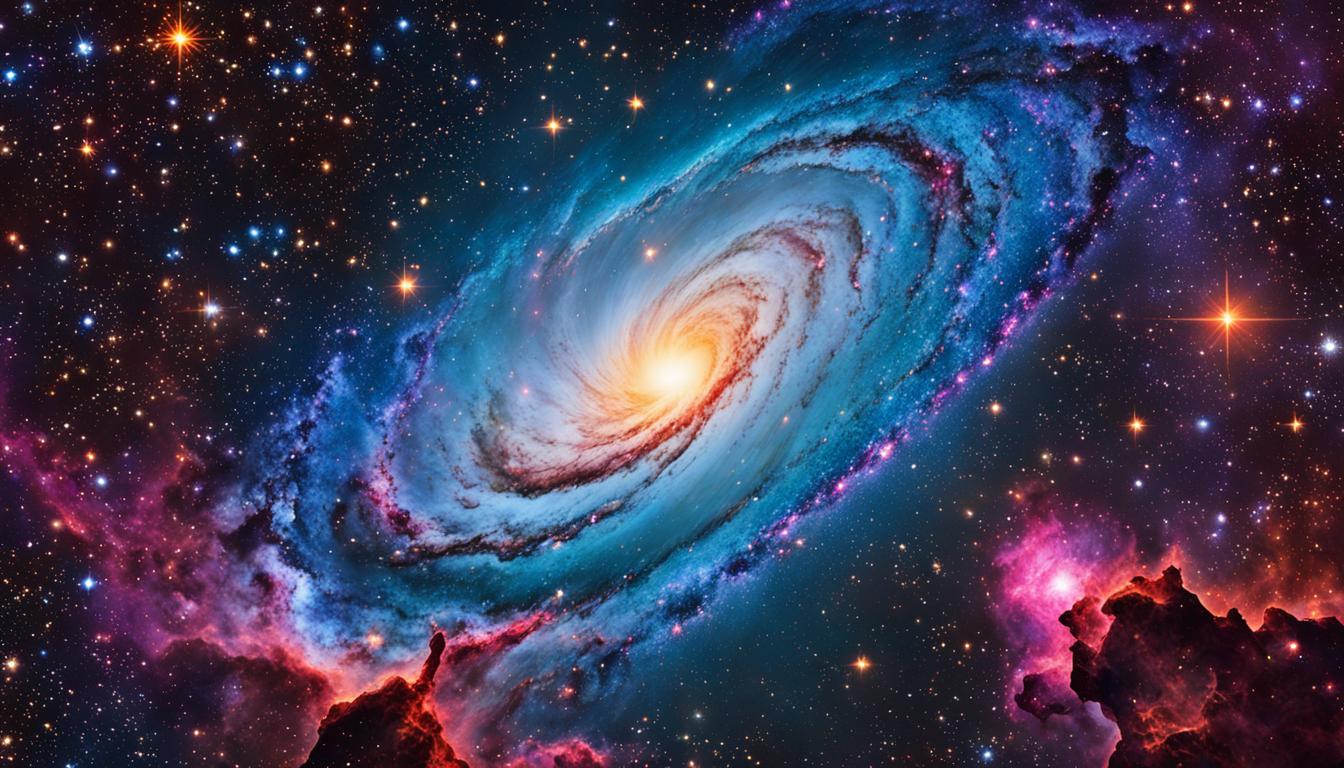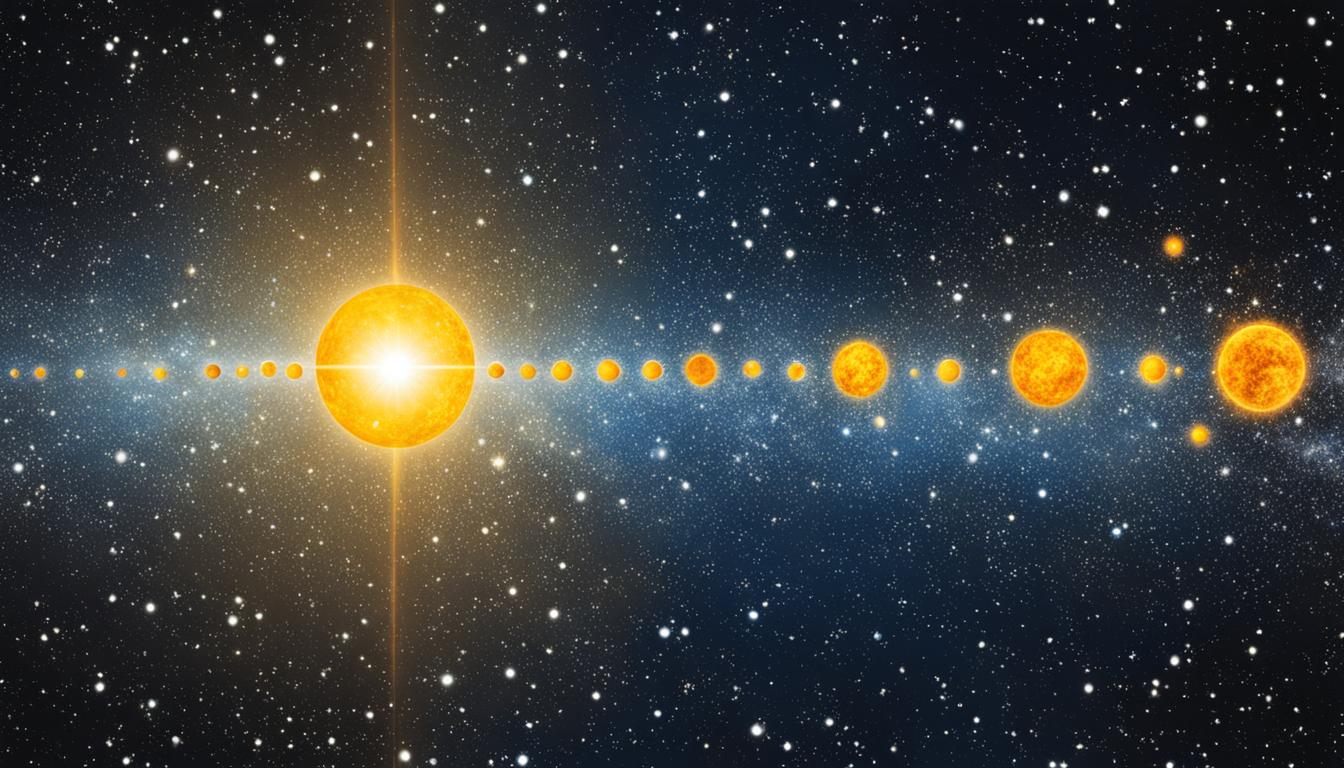Every night, you look up at the sky, and there are millions of little dots; some are bigger, and some are smaller. Do you ever think about them, what they look like, and if they are the same? You might wonder about the types of stars and what are the different types of stars. There are many types, like red dwarfs to hypergiants. Each star type is unique, with its size, brightness, and life cycle.
In astronomy, stars are sorted into seven main groups: O, B, A, F, G, K, and M. This system helps us learn about them. The hottest stars are O-type, while the coolest are M-type. The grouping system used is called the Morgan-Keenan (MK) system.
The most common star, the red dwarf, is often not visible because it’s dim. Despite being small, they can shine for trillions of years. On the other hand, the rare O and B-type stars are bright and hot but live shorter lives.
See also: Definition of the Doppler Effect
By exploring stars in the universe, we learn from the blue, hot O-types to the yellow, like our Sun. Each type tells us more about space and its wonders. I’ll explain the types of stars, how we classify stars, and all the details about the different types of stars.

Introduction to Stellar Classification
Stars are sorted into different groups called spectral types. This lets us understand the universe better. The types are based on colors and patterns seen in the light from stars. These change with a star’s heat and outer layer.
Stars are grouped by how hot or cold they are. The groupings are labeled O, B, A, F, G, K, and M. O stars are the hottest, and M stars are the coolest. Within these groups, stars are further divided from 0 to 9, showing temperature shades. Apart from these, there are special groupings for white dwarfs, carbon stars, and other rare types. There are also different star classification systems, too. They use different systems to classify them with more or less detail.
Morgan-Keenan Classification
The Morgan-Keenan system adds even more detail. It splits stars based on their size and brightness. This is seen in the width of dark lines in their light. The system ranges from O (very hot, very large) to M (cool and small) stars.
Harvard Spectral Classification
The Harvard system began the work to order stars by heat. Later, the Yerkes system made it more detailed. This system looks at how hot a star is and how much gravity it has. The classes go from I (hottest, biggest) to VII (coolest, smallest).
What are the types of stars?
There are many types of stars sorted by their journey and features. The Morgan-Keenan system, from 1943, is used. It groups stars based on their temperature and brightness, from O-types to M-types.
Main-sequence stars, about 90% of all stars, include red dwarfs. These are the most common. For example, Proxima Centauri, our closest star, is a red dwarf. They last a very long time, up to 10 trillion years, by burning hydrogen very slowly.
Blue stars, especially O-types, are at the other end. They are huge and live fast. Often, they go out in a brilliant supernova, creating neutron stars or black holes.
The life of a star follows a set path:
- Protostars: They form when dense spots in space collapse.
- Main sequence stars: They stabilize by fusing hydrogen.
- Red giants: These bigger stars cool down as they use up their hydrogen.
- White dwarfs, neutron stars, or black holes: They become one of these based on their size.
Our Sun is a G-type main-sequence star, a yellow dwarf in the middle of its life. It will be a red giant in about 5 billion years. Then, it will become a white dwarf.
It’s amazing how stars like red dwarfs, yellow dwarfs, and blue giants all have important roles in the universe. Their different lives and paths show the vast diversity and beauty of stars.
Main 7 Types of Stars
As I said before and explained further, stars have different types. But there are 7 main types of stars that we classify as the bigger guys Each of them has its own traits and lifecycle. These seven types are: O, B, A, F, G, K, and M stars, from the hottest to the coolest.
O-Type: Blue Stars
O-type stars are the largest and the hottest, shining brightly in blue. They have unique Helium-II lines and live short but intense lives. Often, they end with a bang in supernovae, forming black holes or neutron stars.
B-Type: Blue-White Stars
The B-type stars are a bit cooler but still shine in a blue-white light. They’re quite hot, too, making them a key part of the sky’s beauty.
A-Type: White Stars
A-type stars glow in a clear white, highlighting hydrogen in their makeup. They stand out in the birthplaces of new stars thanks to their bright light.
F-Type: Yellow-White Stars
F-type stars have a yellow-white hue and are a bit cooler than others. Many of them are stable, which is key in finding planets beyond our solar system.
G-Type: Yellow Dwarfs
G-type stars, like our Sun, are yellow dwarfs. They shine in a yellowish-white light and are a common sight in the Milky Way. They account for around 10% of our galaxy’s stars.
K-Type: Orange Dwarfs
K-type stars, glowing orange, are known for their long-lasting, stable nature. More common than G stars, they’re top choices in the search for life-friendly planets.
M-Type: Red Dwarfs
M-types, or red dwarfs, are the most plentiful and the coolest of stars. They can burn for trillions of years. This makes them an essential part of our universe’s starry scene.
Giant and Supergiant Stars
Stellar phenomena in the universe include giant and supergiant stars. They are known for their huge sizes and stand out in our night skies. These stars have moved beyond their initial stage and now burn helium. This process leads to their massive growth and increased brightness.
Red Giants
In the night sky, red giants are one of the most impressive sights you can find. They are over 100 times bigger than our Sun. Red giants have finished their hydrogen fuel and now fuse helium. This gives them their characteristic red coloring. A well-known red giant is Aldebaran in the Taurus constellation, easily visible due to its brightness.
Blue Giants
Blue giants are not as common but are striking because of their extreme heat and brightness. They have a distinct blue tint. Rigel, in the Orion constellation, is a famous blue giant. It stands out as a key example of these massive and bright stars.
Red Supergiants
Red supergiants surpass red giants in both size and brightness. They’re so big that if placed in our Solar System, they could reach beyond Saturn. Betelgeuse in Orion is a well-known example. These massive stars are near the end of their lives and may explode as supernovae.

Blue Supergiants
Among the hottest stars are the blue supergiants. Their temperatures range from 3,400 K to over 20,000 K. These stars are classified as O to A spectral types and are very young. They burn hydrogen rapidly. Notable among them are Rigel and Deneb, essential stars in their constellations.
White Dwarfs, Neutron Stars, and Black Holes
Star deaths reveal amazing objects like white dwarfs, neutron stars, and black holes. These remains show the incredible variety of the universe’s most extreme features.
White Dwarfs
White dwarfs mark the final stage for stars with a mass up to eight times our Sun’s. After they lose their outer layers, these stars get very dense. They’re incredibly dense but not as much as neutron stars and black holes. The Hubble Space Telescope found over 75 white dwarfs in the M4 globular cluster in 1995. This cluster, 7,000 light-years away, shows us how stellar bodies evolve. Young white dwarfs can be as hot as 100,000 degrees, emitting X-rays from inside.
Neutron Stars
Neutron stars are what’s left after a star explosion when the star was initially eight to 20 times our Sun’s size. They become extremely dense. The process of their cooling is nearly undetectable. Found in 1967 due to radio signals, neutron stars, which are sometimes pulsars, spin very fast. This is because of how their energy and magnetic fields interact. They emit tons of neutrinos when they form, making them even more fascinating.
Black Holes
Black holes form from the hearts of stars much bigger than our Sun. They create a gravitational pull stronger than light, with a point called the event horizon. Nothing can escape a black hole once past this point. In pairs with another star, a black hole might be known by the size of its companion. This aspect of star death presents one of physics’ most profound puzzles.
Protostars and T Tauri Stars
It’s essential to know how stars form to grasp their early life complexities. Two key phases are the birth stage, called the protostar phase, and the start of T Tauri stars.
Protostars are newborn stars formed from gas clouds. They’re the earliest step in star life. These stars form over about 100,000 years, starting the journey from clouds to stars.
Characteristics of T Tauri Stars
T Tauri stars are young, showing us a key turning point after protostars. They are under ten million years old. They have strong stellar winds but don’t have nuclear fusion like mature stars.
In places like Chamaeleon, T Tauri stars are five to six million years old. Others can be found to be even younger than ten million years. They are a step between baby stars and stars like our Sun, telling us about star and planet formation.
The nearest ones, in the Taurus and ρ-Ophiuchus clouds, are about 400 light years away. They stand out due to how their light changes. This comes from sunspots and other reasons that change their brightness.
T Tauri stars match well with what our theories and observations predict. This makes them great for studying with big telescopes. Learning about them tells us more about how stars like our Sun and planets formed billions of years ago.
What is the Most Common Type of Star?
When we look up at the night, we see the stunning blue stars. But the most common star type is actually not so bright. Red dwarf stars are the most abundant. They are hard to spot because they give off less light. These stars are cooler and live longer, making up most of our galaxy’s stars.
Stars are classified by their temperature into seven types, from O to M. M-stars, or red dwarfs, are the most numerous. They makeup 76% of all stars and can live for 10 trillion years. NASA explains that their long life comes from using hydrogen fuel very effectively.
Red dwarf stars are small, between 7.5% to 50% of the Sun’s size. Despite their number, they don’t shine bright. This is unlike blue stars, which are known for their short lives and bright light when they die.
Blue giant stars and supergiants are rare next to red dwarfs. They stand out with their blue colors and quick hydrogen use. This shows that red dwarfs are the real stars of the universe, quietly twinkling away.
What Type of Star is Our Sun?
Our Sun is a classic example of a G-type star. These are known as yellow dwarfs for their unique features. The Sun’s surface temperature is about 5,500 degrees Celsius. This puts it right in the middle of G-type stars, which range from 2,400 to 7,500 Kelvin.

The Sun is actually white, not yellow, to us. This is because it mixes all its colors. In the Milky Way, yellow dwarf stars like our Sun make up 7% of stars. That’s key when you consider there are hundreds of billions of stars and about 200 billion planets in our galaxy.
Our Sun is important not only for shining light on Earth. It also falls within the usual mass range for G-type stars, usually 0.84 to 1.15 solar masses. These make it a great example of a sun star type. Around half of the yellow dwarfs in the galaxy have planets. This hints at the possibility of life beyond Earth.
Conclusion
To sum up, stars are not just one type. Like, when you look up at the sky on any given night, you actually see a variety of stars; some are more common than others. Sun is also a type of star, for example. Other types of stars can range from the smallest red dwarfs to the biggest hypergiants. Stars evolve uniquely from birth to their final form, showcasing the beauty and complexity of our cosmos.
Generally, their lifetime, how they evolve, how they shine, and how they die are all different. Some of the stars take an extremely long time to be born, whereas others can born relatively quickly. Some become black holes when they die, and some become other types of dead stars.
Overall, there are 7 main types of stars, and we classify them based on different methods. NASA helps us understand them further.
FAQ
What are the different types of stars in astronomy?
There are many types of stars. They are based on their size, temperature, color, and lifecycle stage. For example, there are main-sequence stars and others like giant and supergiant stars. You also have white dwarfs, neutron stars, and black holes.
What is the spectral classification system?
The spectral classification system groups stars by looking at their spectral lines. These lines show a star’s temperature and density. Stars are labeled with types from O to M, showing their heat level.
What are the main stages in the lifecycle of a star?
A star’s life starts as a protostar and then becomes a main sequence star. It might then turn into a red or supergiant. Finally, it can become a white dwarf, neutron star, or black hole. Each phase changes how the star looks and acts.
What are the 7 main types of stars?
Stars are classified from O (the hottest blue stars) to M (the coolest red stars). There are also B, A, F, G, and K types in between. Each type’s color tells us about its temperature.
What are giant and supergiant stars?
Giant and supergiant stars are much bigger and brighter than our Sun. Red and blue giants mark the end of a star’s life. Supergiants are even larger and very bright. They end in a powerful nova or supernova event.
What are white dwarfs?
White dwarfs are the leftover cores of smaller stars. They are incredibly dense; a white dwarf the size of Earth is as heavy as the Sun. This means they are very compact and heavy objects.
What are black holes?
Black holes are what remains after a big star explodes and collapses. They have such strong gravity that not even light can escape. We can’t see them, but we know they’re there because of how they affect things around them.
What are protostars?
Protostars are very young stars, just forming from gas clouds. They are still growing and haven’t started nuclear fusion. This stage in a star’s life lasts for about 100,000 years.
What is the most common type of star?
The most common star is the M-type, also known as a red dwarf. These are cool, dim stars with long lives. They last longer than other types of stars.
What type of star is our Sun?
Our Sun is a G-type star, often called a yellow dwarf. It looks white from Earth because it combines all colors of light. This is the type of star our planet orbits.